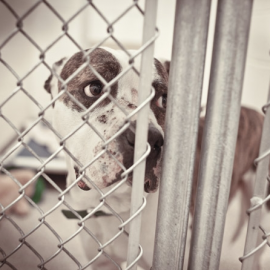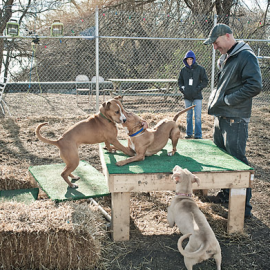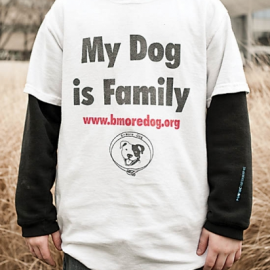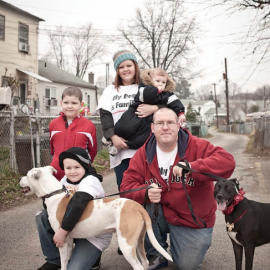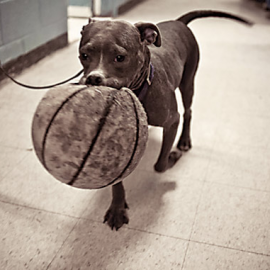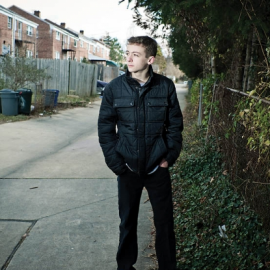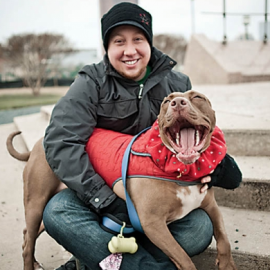News & Community
Tough Love
After Maryland’s highest court finds pit bulls “inherently dangerous,” the breed’s supporters take their fight to the General Assembly.
Still carrying his Nerf dart gun, 10-year-old Dominic Solesky ran outside and down the alley behind his family’s East Towson row home after hearing his friend, Scotty Mason, screaming.
“We’d played baseball earlier in the day, and we were playing tag,” Dominic recalls five years later. “Two of our other friends met me at the gate on the side of the alley and said they saw him get attacked. I ran down and saw his Nerf gun and blood on the pavement—and then I saw the pit bull trying to jump out of its kennel.”
The pit bull’s owner had pulled his dog off Scotty and had already begun cleaning up the 9-year-old’s face and shoulder when Dominic arrived on the scene. As the owner, in his kitchen, was warning Scotty not to tell his parents what had happened, the dog leapt off the back of another pit bull in the kennel and got free.
“I was scared and started running toward my house,” says Dominic, who weighed about 60 pounds at the time. “I looked behind me and saw my two friends—one went over a fence and the other hid next to a telephone pole—and the dog gaining ground. I kept running, but he caught me and jumped on my back and knocked me down. I tried to push him off, and he bit my arm and then he bit my face.
“It was sort of pouncing on me and barking all at once.”
By the time the owner pulled his pit bull, Clifford, off Dominic, the dog had ripped opened his thigh and severed his femoral artery.
Witnessing the attack and seeing Dominic lying in an expanding pool of blood, a neighbor dialed 911, pleading through tears for assistance.
“I just saw a dog attack a little boy. He’s covered in blood. He cannot walk,” the woman says on a tape of the emergency call. “This boy needs medical attention now . . . he’s hurt bad. . . . We need help now! We need help now!”
“Is the boy conscious?”
“Barely.”
“Please hurry.”
Another neighbor rushed over and applied pressure to the gaping wound, hoping to stem the bleeding until an ambulance arrived.
“It didn’t look like a dog bite,” says Dominic’s mother, Irene, who also ran to her son. “It looked like a shark attack.”
Later, as doctors at The Johns Hopkins Hospital emergency room worked to save Dominic’s life, the Baltimore County Fire Department dispatched a “wash detail” to the alley to clean up his blood. Dominic eventually underwent a second surgery and spent a year in rehab. Afterwards, the Solesky’s civil claim against the pit bull’s owner was discharged when the man filed for bankruptcy protection. However, Anthony Solesky, Dominic’s father, also sued the pit bull owner’s landlord for negligence, alleging knowledge of the dog’s “vicious” nature in court papers.
With Dominic left with several scars but otherwise long-since recovered and a member of his high school’s wrestling team, that lawsuit finally completed its circuitous journey through the Baltimore County and Maryland judicial systems last spring. The state Court of Appeals (Maryland’s highest court) ruling: Pit bulls are “inherently dangerous” and, therefore, a landlord with knowledge of a pit bull on their property can be held “strictly liable”—automatically culpable, in other words—for the dog’s actions. For all intents and purposes, the court’s decision set a new precedent, negating the state’s so-called “free-first-bite” rule, which held that in order for a dog’s owner—not to mention, a landlord—to be liable, a dog must be shown to have bitten previously. Suddenly, pit bulls became the exception to that rule.
State Farm, the landlord’s homeowner’s insurance carrier in Dominic’s case, quickly settled out of court with the Soleskys.
The real fight, however, was just beginning. Days after the court decision, a Baltimore Sun column by Dan Rodricks supporting the ruling and characterizing pit bulls as “four-legged time bombs” ignited a firestorm of online comments from pit-bull lovers. Over the next few weeks, Facebook, pit-bull-friendly websites, and editorial pages lit up in outrage over the court’s “breed-specific” decision. A month after the ruling, under intense pressure from pit bull advocates and the rescue community, which included a rally in Annapolis, the General Assembly set up a Pit Bull Task Force. But in a special session this fall, legislators failed to pass a bill addressing the court decision.
And while pit bull supporters and the rescue community are concerned that shelters, dog parks, animal hospitals, and third parties can be held automatically liable for the actions of pit bulls on their property, their more pressing worry has been that landlords would force tenants and families to choose between their pets and their homes. Not without good reason. In the aftermath of the Court of Appeals decision, organizations such as the Maryland SPCA, the Humane Society of the United States, and the Baltimore Animal Rescue and Care Shelter (BARCS), received hundreds of calls from panicked pit bull and crossbred pit bull owners about the impact of the decision. (The court has since ruled their decision only applies to purebred pit bulls.) At last count at BARCS, more than 40 pit bull owners have given up their pets to the shelter following the court ruling, with many explicitly mentioning eviction warnings from their landlords.
“It’s been heartbreaking at times, parents with children, everybody crying, including our staff members and other customers,” says Jennifer Brause, BARCS’s executive director. “This has been hard for everyone. We even had a purebred boxer come in—a dog that obviously isn’t a pit bull—because the landlord thought it was a pit bull and suddenly got nervous after the ruling. The tenant didn’t have the resources to fight and, in the end, was afraid of retaliation by the landlord.”
Meanwhile, pit bull supporters continue their campaign for legislative action to override the pit-bull-specific language in the Court of Appeals ruling. Among other events, the SPCA of Anne Arundel County hosted its first Pit Bull Appreciation Month this fall. B-More Dog, a pit bull outreach and education organization launched in 2007 as Baltimore County considered pit-bull-specific legislation in the wake of Dominic’s attack, hosted a “Holiday Pit Bulls on Parade” walk at the Inner Harbor in December. And this month, Pact for Animals will host a daylong, “Punish the Deed, Not the Breed” symposium at the University of Baltimore.
“This pit bull ruling is so difficult because it started as a court decision and not in the legislature, where it bubbled up almost immediately afterwards,” says Aileen Gabbey, executive director of the Maryland SPCA, who has testified in Annapolis about the ruling. “Animal welfare groups were really taken aback, obviously upset, and very worried about what this meant for pets and people. There was the [Annapolis] rally and animal-rights groups started getting phone calls to their legislators, who, to their credit, listened to their constituents. The more they heard, the more they realized they needed to act.”
Elected officials are readying to tackle the issue again in the General Assembly. But the question remains, can the state Senate and House find a way to protect the public from vicious dogs without harming families who love their pit bull pets? Right now, pit bull owners and landlords remain in a kind of limbo as another lawsuit—this one filed in federal court by Baltimore City pit bull owners—challenges the constitutionality of evictions based on the Maryland Court of Appeals decision.
Late last summer, the pit bull uproar galvanized when the management board that oversees East Baltimore’s low-income Armistead Gardens housing co-op, a neighborhood of roughly 1,500 homes, sent a letter to leaseholders ordering them to give up their pit bulls and threatening legal action, “including termination” of leases. In reaction, Armistead Gardens resident Joseph Weigel reached out to the law office of Barry Glazer, filing a federal suit, later joined by neighbors Joanna Profili and Jenine Gangi and amended to a class-action complaint, that alleges, among other things, the wrongful abrogation of their property rights and an unjust attempt to terminate their leases. All three express a deep affection for their pit bulls.
Weigel is described as “the disabled owner of Angel, a loving and obedient dog believed to be a pit bull or pit-bull mix” in court papers. Profili, a 28-year-old single mother of two and a machine operator recently laid off from her job, is raising her children alone after their father was tragically killed on Christmas Eve, 2011. According to the suit, she wants to avoid having to give up the family’s beloved 2-year-old pit bull, “which serves as a reminder to her children of happier times with their father.”
Gangi, a veterinarian’s assistant at the Essex Middle River Veterinary Center and a trainer at PETCO in the Golden Ring Mall, has two crossbred pit bulls, Tank Girl, 6, and Baby Girl, 2, who also serve as blood donors at her veterinary clinic.
“Since the court decision was made, it’s been very stressful,” Gangi says. “People became very paranoid that their dogs are going to be taken away or they’re going to be forced to move. For me, my dogs are my children. I think of Tank as my ‘first born.’ They’re very social animals—they play tricks, they play dead—and they’ve gotten me though some rough times. If my dogs were ever taken away, I’d be devastated.”
“There’s an estimated 500 pit bulls or pit-bull mixes in Armistead Gardens, but this really impacts Maryland as a whole,” says Charles H. Edwards IV, an attorney in Glazer’s office, which has taken the case pro-bono. “We made a decision to attack the law and not just seek relief for the three Armistead Gardens residents. This shouldn’t be allowed to stand in Maryland.”
Christopher Moll, another Armistead Gardens resident, a married refrigeration technician with three kids, and the owner of a 4-year-old pit mix named Dahlia, is not a part of the federal complaint, but has become a pit bull activist following the court’s ruling. He participated in a B-More Dog pit bull event outside the local elementary school as well as attending the organization’s “Holiday Pit Bulls on Parade” downtown with his family.
Moll believes that the court ruling and surrounding media attention has not just frightened pit bull owners, but likely has also scared off potential owners from adopting animals—something Brause mentioned as well. “I’ve been to BARCS and the Baltimore County Animal Shelter and interacted with the dogs there and taken them out,” he says. “They’re approachable, they’re not dangerous.”
Moll maintains, as do all pit bull supporters, that the problem is not the pit bull breeds, generally considered the American pit bull terrier, the American Staffordshire, the Staffordshire bull terrier, or mixes thereof, but each dog’s training. “Their behavior is all based on how the dogs are raised, it’s definitely not the breed,” Moll says. “Our dog has never showed any signs of aggression. My kids have jumped up and down on her, pulled her ears, and stuck their hands in her bowl when she was eating.”
In its decision, the Court of Appeals painted a different picture of pit bulls as it highlighted its long frustration with existing law, or lack thereof, regarding attacks, noting the mauling of another 10-year-old Maryland boy, John L. Clark, in a case that came before the court in 1916. More recently, over the past 13 years, the court said in its opinion, “there have been no less than seven instances of serious maulings by pit bulls upon Maryland residents resulting in either serious injuries or death that have reached the appellate courts . . . including the two boys attacked by the pit bull in the present case.”
In its opinion, the Court of Appeals cited, among other studies, research published in the Journal of the American Veterinary Medical Association that found that from 1979 through 1996, dog attacks caused more than 300 U.S. fatalities, and that pit bulls were involved in approximately one-third of the deaths during a 12-year period from 1981 through 1992.
While the pit bull controversy here garnered not just local and state headlines, but national attention, it is hardly the first time legal questions and legislation around pit bulls in the state has popped up.
In an effort to protect the public, cities and counties have often taken matters into their own hands, passing pit-bull-specific legislation. Most notably, Prince George’s County banned pit bulls outright in 1996 following several attacks. Baltimore County, as mentioned earlier, considered requiring pit-bull-specific licensing and liability insurance in the aftermath of Dominic’s attack. This summer, Hagerstown’s City Council considered strict liability legislation on pit bull owners and landlords, but ultimately placed the proposed ordinance on hold. Two small Maryland towns, North Beach and Port Deposit, also outlawed pit bulls in recent years. North Beach, however, rescinded the ban this summer.
According to DogsBite.org, a national dog-bite victims’ group, which monitors attacks, breed-specific legislation, and court rulings, more than 500 municipalities and 18 counties in the U.S. have some type of pit-bull-specific law. Founded by Colleen Lynn, whose arm was broken in a pit-bull attack, DogsBite.org also reports that 23 countries regulate pit bulls and “dangerous dog” breeds with national breed-specific laws.
Although pit bulls have a complicated history—bred in England to “bait bulls” (a popular blood sport where dogs fought tethered bulls) and, later, in the U.S. to fight each other—pit bulls and pit-bull mixes have not always had such a bad reputation. For a long time, they were the all-American dog in the country’s imagination. The Little Rascals’ dog “Petey” was a pit bull; so was Buster Brown’s dog. Theodore Roosevelt had a pit bull terrier named “Pete.” Helen Keller’s companion was a “pittie” named Sir Thomas. Gen. George Patton had a white pit bull named “Willie” and pit bulls served as U.S. military mascots and in combat during both World Wars.
Lynn believes that the number of pit-bull attacks—and, therefore, their aggressive reputation—is linked to an explosion in the number of pit bulls since the late 1970s. She puts the cause of the problem at the feet of irresponsible owners and breeders, as well as an increase in the number of dogs exploited for fighting—or at the very least—their macho image. But Lynn also believes pit bulls to be dangerous regardless of how well-bred or how well-trained they may be, due to what she describes as their “hold-and-shake” biting style and inherent tenacity.
The bottom line, says Marcy Setter of Pit Bull Rescue Central, an online resource for pit bull owners, is that there are not any easy answers.
Pit bulls can be mishandled, abused, and taught to be aggressive.
They can also be wonderful family pets.
“Everybody wants you to wave a magic wand,” Setter says. “We need to move slowly in the right direction, but breed-specific legislation doesn’t work—it’s expensive for local animal control and identification alone is too complicated.” (When is a pit-bull mix defined as a pit bull, for example?)
Instead of breed-specific laws, Setter says elected officials should propose incentives to spay and neuter and stronger leash laws, including enforcement and higher fines, that can fund a more-responsive animal control effort. “It’s a horrible situation when a victim is attacked and that should never happen to anyone,” she says. “The problem is important, and we need laws. But we should write laws so that animal control can be proactive and respond to neighbors’ complaints. Usually, there are harmful signs before something happens.”
Gabbey, the Maryland SPCA executive director, says much the same thing. “There are leash laws and in a lot of quarters of the city, the rules are broken,” she says. “Ideally, it’d be nice, when a fence is broken or a neighbor makes a complaint providing a dog’s address, that there’d be a response. Right now, typically, animal control is only reactive. I’d say in most communities, animal control is woefully underfunded, and without that, these things are hard to do.”
To the current controversy, Gabbey notes that state legislators heard from concerned constituents throughout the state about the urgency around the pit bull ruling before the second special season last year and will again during the regular session. “Pit bulls owners of Maryland want to see this resolved,” she says. The Senate and House, once they began working during the special session, took different approaches to crafting a solution—although they did find some key common ground.
Both chambers proposed bills to override the Court of Appeals’ pit bull-specific language and treat all breeds the same. Both also considered lowering the strict-liability threshold for landlords.
However, the Senate also agreed with the Court of Appeals’ decision in removing the old, “free-first-bite,” common-law guideline, says Montgomery County state Sen. Brian Frosh, a co-chair of the Pit Bull Task Force.
The House legislation, on the other hand, essentially created more liability exemptions for dog owners than the Senate bill. Pit bull owners, under the House proposal, would be held strictly liable, for example, if their dog was off leash.
“The main difference between the Senate bill and the House bill was that the Senate bill would’ve aligned Maryland with about 35 other states that have eliminated the so-called ‘one-free-bite’ rule,” says Frosh. “I’m optimistic, but we still need to reach a consensus.”
“We are all anxiously awaiting for the legislative session to start,” says Gabbey. “People who are landlords and people who own pit bulls are still worried until legislation is passed. Frankly, I think a lot of damage has already been done.”

